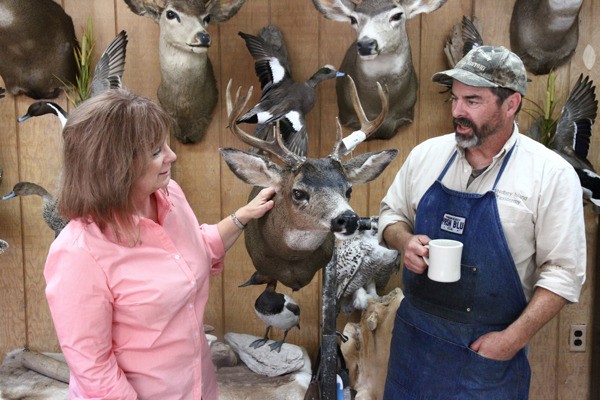Walking into Whidbey Island Taxidermy is like entering a natural history museum, but nothing is behind glass. A large variety of animals — ducks, owls, hawks, falcons, black-tailed deer and a fox — hang on the wall or stand posed on the floor. Some of the birds are mounted as though in flight, with their wings fully outstretched and their bodies banked as if in mid-turn.
Matt Klope stuffed them all.
Klope and his wife, Joan, have run the business in Oak Harbor since the mid-1990s, though Matt said he has been fascinated with animals as long as he can remember.
Growing up in Ventura, Calif., “I was collecting bird feathers when I was four, taking apart dead birds in elementary school and cleaning and reassembling a barn owl skeleton for a ninth-grade science project,” he said.
He earned a bachelor’s degree in wildlife biology from Humboldt State University, but even before graduating went to work for the Navy in 1979 as a civilian biologist. Working at Naval Air Station Point Mugu in California, he was in charge of endangered-species management and hunting and research programs.
It’s standard operating procedure for Navy bases to employ biologists who manage their resources, he explained.
Teaching himself taxidermy though books, video tapes and observing others, he began mounting birds for on-base hunters and the two privately owned gun clubs next to the base.
Matt and Joan moved to Oak Harbor in 1989 so he could do the same job at NAS Whidbey. He initially did taxidermy from his home’s laundry room, kitchen and garage. Five years ago he built “Man Land,” a large, airy studio adjacent to the house. In January he left the Navy with a good retirement package.
Now 58, he spends nearly full time hunting or working in his taxidermy studio.
Klope specializes in waterfowl, because “it’s more artistic than doing deer heads” — though he also does deer heads and full body mounts. He’s currently working on making a rug from a black bear killed in Idaho and on tanning an elk hide at least 10 feet long.
The business welcomes some unusual requests, but not all.
Klope has mounted six tiny moles and plans to assemble them into a hanging “mole-bile” (mobile) for a customer who detests the way those creatures plow up his lawn. He’s mounting a mole head on a tiny wood plaque for the same man.
If asked — and he frequently is — he makes coin purses out of a deer’s tanned penis and scrotum. He has skinned a former pet rabbit brought to him by a grieving owner.
But he draws the line there, refusing to mount pets.
“I tried it once, and it turned out really nice. The owner walked in and said, ‘It doesn’t have his spirit.’ I said, ‘It’s dead!’ and I was done with pets.”
And don’t bring in that dead bird that hit your window and expect to keep it. Under the Migratory Bird Treaty Act of 1918, it’s unlawful for ordinary folks to own nearly all kinds of dead birds, Klope said. Birds hunted with a license are an exception, as are those brought in by the public and donated to the Audubon Society, like most of those in Klope’s studio.
For years his studio served as the Society’s display room. Now he has only specimens awaiting pick-up.
Klope’s taxidermy skills, combined with his biology background, have made him a perfect choice for Smithsonian Institution expeditions to collect and preserve specimens in Djibouti, El Salvador, Hawaii, Iceland and Japan. In January, he plans to be part of a sixth expedition, again to Djibouti.
“I can prep birds and mammals fast and good. That combination of skills has opened so many doors,” he said.
He is supplying pieces of deerskin and rabbit hides for a “touch-me” display at Padilla Bay’s Breazeale Interpretive Center. He does ranger talks at Deception Pass State Park and serves on the park foundation’s board. He welcomes children to his studio and happily shows them cases full of skulls and a wall covered with touchable animal hides. He has volunteered for the Central Puget Sound Marine Mammal Stranding Network and helped prepare the gray whale and the Steller sea lion skeletons that hang inside the Coupeville Wharf.
The taxidermy business generates “fun money” but not enough to make a living, the couple said. “I don’t do big heads like elk, caribou or moose, and I don’t want to do African animals” that Seattle-area residents shoot on hunting trips, he said. “I keep busy doing bear rugs, local deer heads and waterfowl.”
The studio charges $250 for a mallard and $450 for a mounted deer head. “If it’s not on our website’s price list and it’s weird, it’s $100,” Klope said.
Joan, 56, handles paperwork, taxes, the website and “the things Matt doesn’t like doing,” she said. “It’s very much a husband-and-wife business.”
Whidbey Island Taxider-my “does great work,” said Dennis Hunsinger, a Langley hunter who brought in a four-point black-tailed deer head to be mounted. “It’s reasonably priced, local and quick.”
For information log on to www.whidbeyislandtaxidermy.com



